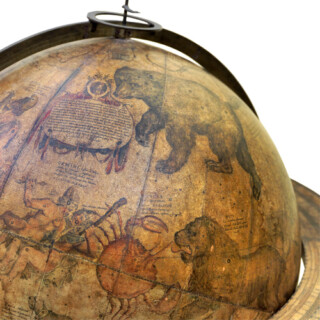The Passage of the Annular Penumbra over Scotland
&c. In the Central Eclipse of the Sun on the 18.th day of February 1736/7 in the Afternoon. Humbly Inscrib'd to the President, Council and Fellows of the Royal Society. By Thomas Wright of the City of Durham NB. Mr. Wright has lately publishd by Subscription the Perpetual Pannauticon or Universal Mariners Magazine, being a Mathematical Instrument 18 inches Diamr. describing the Lunar Theory and motion of the Tides. To be had of the Author & at Mr. Senex's.
London
John Senex
1736
Engraved print, slight foxing at upper left and in upper right corner, otherwise good condition
390 by 505mm. (15.25 by 20 inches).
11299
notes:
Wright's second predictive map of the 1737 eclipse is altogether more accessible; the passage of the penumbra is overlaid on a simple map of the British Isles, the track marked by a shaded band running from south-west to north-east, passing directly over Edinburgh. There are fifty-two drawings of the eclipse placed over the map; that the eclipse would be total at Edinburgh is designated by the shadow of the moon being drawn at totality, with the full annular effect (when th...
bibliography:
Shirley, Printed Maps of the British Isles 1650-1750, Senex 8 (ill.): recording only BL, Maps 177.d.1.(19.); Armitage, Shadow of the Moon, Map [11] & p. 17 (col. ill.): also recording only the BL exemplar; Worldcat adds University of Southern Maine, Osher Map Library, Rare SM-1737-4; Harvard Houghton Library, EB65 A100 B675b v.5 (Marquess of Bute broadsides).
provenance:
![NAYLOR, Joseph [Sheet entitled:] 'An Astronomicall and Chronologicall Clock,](https://i0.wp.com/crouchrarebooks.com/wp-content/uploads/2025/03/1650_1H.jpg?fit=1258%2C1900&ssl=1) A previously unrecorded state of a rare promotional broadside for an astronomical clock
A previously unrecorded state of a rare promotional broadside for an astronomical clock 







